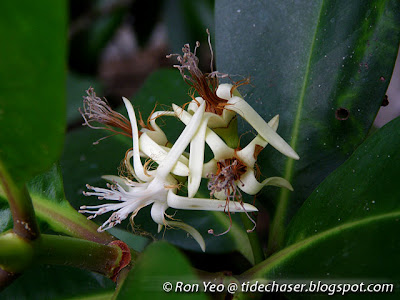The Pisang-pisang Laut (Kandelia candel) is a nationally critically endangered mangrove tree from the family Rhizophoraceae. It occurs at the landward side of mangrove forest or along tidal rivers, usually on sandier substrates, occupying a narrow niche. The last known tree on mainland Singapore died in February 2011. A small population can be found offshore on Pulau Tekong and Pulau Unum.
The flowers are white and occur in clusters, dichotomously branched.
The leaves are narrowly oblong with a rounded tip. The tree has a thickened stem base without proper buttresses or pneumatophores. It has greyish to reddish-brown bark with lenticels for air exchange.

The new leaf buds are laterally compressed and twisted, and are protected by prominent stipules which fall off as the leaves mature.
Vivipary is observed in this plant, as with the other mangrove species from the family Rhizophoraceae. This is a condition whereby the embryo grows and break through the seed coat and the fruit wall while still attached to the parent plant. Hence, the long and green structures seen hanging from the trees are seedlings, and only the brown structures at the top of the green structures are the fruits. The seedling's hypocotyl is narrowly cylindrical with a somewhat pointed tip, growing up to 40 cm long. It is capped by the persistent sepals whose tips bend backwards towards the stalk.

Unfortunately, I do not have pictures of the seedlings of K. candel. What I have above are the seedlings of a closely related species - Kandelia obovata. Previously it was thought that there was only one species of Kandelia - K. candel. Studies published in 2003 showed that there were actually two different species, and the ones growing in the sub-tropical areas north of the South China Sea are renamed K. obovata. The seedlings are similar though.
The wood is used as firewood, making enclosures and stakes. It is also and source of tannin.
References
- Chong, K. Y., H. T. W. Tan & R. T. Corlett, 2009. A Checklist of the Total Vascular Plant Flora of Singapore: Native, Naturalised and Cultivated Species. Raffles Museum of Biodiversity Research, National University of Singapore. Singapore. 273 pp.
- Giesen, W., S. Wulffraat, M. Zieren & L. Scholten. 2006. Mangrove guidebook for Southeast Asia. RAP Publication 2006/07. FAO Regional Office for Asia and the Pacific & Wetlands International. Bangkok. 769 pp.
- Ng, P. K. L. & N. Sivasothi. 1999. A guide to the mangroves of Singapore 1 : the ecosystem & plant diversity. Singapore Science Centre. Singapore. 168 pp.
- Sheue, C.-R., H.-Y. Liu & J. W. H. Yong. 2003a. Kandelia obovata (Rhizophoraceae), a new mangrove species from Eastern Asia. Taxon 52: 287- 294.

No comments:
Post a Comment